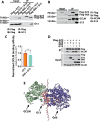Prevention of age-related truncation of γ-glutamylcysteine ligase catalytic subunit (GCLC) delays cataract formation
- PMID: 38669339
- PMCID: PMC11051666
- DOI: 10.1126/sciadv.adl1088
Prevention of age-related truncation of γ-glutamylcysteine ligase catalytic subunit (GCLC) delays cataract formation
Abstract
A sharp drop in lenticular glutathione (GSH) plays a pivotal role in age-related cataract (ARC) formation. Despite recognizing GSH's importance in lens defense for decades, its decline with age remains puzzling. Our recent study revealed an age-related truncation affecting the essential GSH biosynthesis enzyme, the γ-glutamylcysteine ligase catalytic subunit (GCLC), at aspartate residue 499. Intriguingly, these truncated GCLC fragments compete with full-length GCLC in forming a heterocomplex with the modifier subunit (GCLM) but exhibit markedly reduced enzymatic activity. Crucially, using an aspartate-to-glutamate mutation knock-in (D499E-KI) mouse model that blocks GCLC truncation, we observed a notable delay in ARC formation compared to WT mice: Nearly 50% of D499E-KI mice remained cataract-free versus ~20% of the WT mice at their age of 20 months. Our findings concerning age-related GCLC truncation might be the key to understanding the profound reduction in lens GSH with age. By halting GCLC truncation, we can rejuvenate lens GSH levels and considerably postpone cataract onset.
Figures








References
-
- Cicinelli M. V., Buchan J. C., Nicholson M., Varadaraj V., Khanna R. C., Cataracts. Lancet 401, 377–389 (2023). - PubMed
-
- GBD 2019 Blindness and Vision Impairment Collaborators; Vision Loss Expert Group of the Global Burden of Disease Study , Causes of blindness and vision impairment in 2020 and trends over 30 years, and prevalence of avoidable blindness in relation to VISION 2020: The Right to Sight: An analysis for the Global Burden of Disease Study. Lancet Glob. Health 9, e144–e160 (2021). - PMC - PubMed
-
- Liu Y. C., Wilkins M., Kim T., Malyugin B., Mehta J. S., Cataracts. Lancet 390, 600–612 (2017). - PubMed
-
- Wormstone I. M., Wormstone Y. M., Smith A. J. O., Eldred J. A., Posterior capsule opacification: What’s in the bag? Prog. Retin. Eye Res. 82, 100905 (2021). - PubMed
Publication types
MeSH terms
Substances
Grants and funding
LinkOut - more resources
Full Text Sources
Medical
Molecular Biology Databases
Research Materials
Miscellaneous

